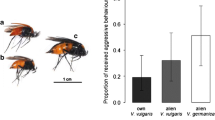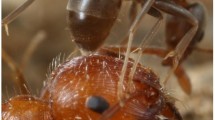Abstract
Myrmecophiles, i.e., organisms associated with ants live in a variety of ecological niches in the vicinity or inside ant colonies and employ different strategies to survive ant encounters. Because different niches are characterized by different encounter rates with host ants, strategies used to avoid ant aggressions should depend on these niches. This hypothesis was studied with three rove beetle species of the genus Pella, which are myrmecophiles of the ant Lasius fuliginosus and the non-myrmecophilous relative Drusilla canaliculata. Behavioral tests in the field revealed that Pella species are better adapted to interactions with ants than D. canaliculata, but that they use species-specific strategies in ant interactions. Pella cognata and Pella funesta avoid encounters with ants by swift movements. Chemical analyses of the defensive tergal gland secretions showed that P. cognata has replaced the aggression inducing undecane by the behaviorally neutral tridecane. P. funesta repels the ants by releasing the panic alarm pheromone sulcatone from its tergal gland resulting in an “ant free space” around the beetles. Finally, Pella laticollis uses a specific and unique appeasing behavior. Behavioral and chemical data did not reveal any indication for the mimicry of the ants' cuticular hydrocarbon profiles by any of the beetle species. It is discussed that the employed strategies correlate with the ecological niches of the beetles. P. cognata and P. funesta are living along ant trails with ample space to escape and the employed strategies are probably sufficient to escape from dangerous conflicts. In contrast, P. laticollis lives in refuse areas of ant nests with frequent ant encounters, and its appeasement strategy allows it to stay at the encounter site.





Similar content being viewed by others
References
Akino T (2002) Chemical camouflage by myrmecophilus beetles Zyras comes (Coleoptera: Staphylinidae) and Diaritiger fossulatus (Coleoptera: Pselaphidae) to be integrated into the nest of Lasius fuliginosus (Hymenoptera: Formicidae). Chemoecology 12:83–89
Akino T, Mochizuki R, Morimoti M, Yamaoka R (1996) Chemical camouflage of myrmecophilous cricket Myrmecophilus sp. to be integrated with several ant species. Japn J Appl Entomol 40:39–46
Anonymus (2009) New SPME guidelines. J Chem Ecol 35:1383
Buser H-R, Arn H, Guerin P, Rauscher S (1983) Determination of double bond position in monounsaturated acetates by mass spectrometry of dimethyl disulfide adducts. Anal Chem 55:818–822
Clarke KR (1999) Nonmetric multivariate analysis in community-level ecotoxicology. Environ Toxicol Chem 18:118–127
Freude H, Harde KH, Lohse GA (1974) Die Käfer Mitteleuropas Band 5. Goecke und Evers Verlag, Krefeld
Hölldobler B (1967) Zur Physiologie der Gast-Wirt-Beziehungen (Myrmecophilie) bei Ameisen - I. Das Gastverhältnis der Atemeles- und Lomechusa-Larven (Col. Staphylinidae) zu Formica (Hym. Formicidae). Z Vgl Physiol 56:1–21
Hölldobler B (1970) Zur Physiologie der Gast-Wirt-Beziehungen (Myrmecophilie) bei Ameisen - II. Das Gastverhältnis des imaginalen Atemeles pubicollis Bris. (Col. Staphylinidae) zu Formica (Hym. Formicidae). Z Vgl Physiol 66:215–250
Hölldobler B, Wilson EO (1990) The ants. Harvard University Press, Cambridge
Hölldobler B, Möglich M, Maschwitz U (1981) Myrmecophilic relationship of Pella (Coleoptera: Staphylinidae) to Lasius fuliginosus (Hymenoptera: Formicidae). Psyche 88:347–374
Howard RW, Blomquist GJ (2005) Ecological, behavioral and biochemical aspects of insect hydrocarbons. Annu Rev Entomol 50:371–393
Hughes DP, Pierce NE, Boomsma JJ (2008) Social insect symbionts: evolution in homeostatic fortresses. Trends Ecol Evol 23:672–677
Kistner DH (1979) Social and evolutionary significance of social insect symbionts. In: Hermann HR (ed) Social insects vol 1. Academic, New York, pp 339–413
Kistner DH, Blum MS (1971) Alarm pheromone of Lasius (Dendrolasius) spathebus (Hymenoptera: Formicidae) and its possible mimicry by two species of Pella (Coleoptera: Staphylinidae). Ann Entomol Soc Am 64:589–594
Komatsu T, Maruyama M, Itino T (2009) Behavioral differences between two ant cricket species in Nansei Islands: host-specialist versus host-generalist. Insect Soc 56:389–396
Maruyama M (2006) Revision of the Palearctic species of the myrmecophilous genus Pella (Coleoptera, Staphylinidae, Aleocharinae). National Science Museum Monographs:32
Seifert B (2007) Die Ameisen Mittel- und Nordeuropas. Lutra- Verlags- und Vertriebsgesellschaft, Tauer
Steidle JLM, Dettner K (1993) Chemistry and morphology of the tergal gland of free-living adult Aleocharinae (Coleoptera: Staphylinidae) and its phylogenetic significance. Syst Entomol 18:149–168
Stoeffler M (2008) Zur Biologie myrmekophiler Kurzflügelkäfer der Gattung Pella (Coleoptera: Staphylinidae) in Baden-Württemberg unter besonderer Berücksichtigung von chemischer Verteidigung und Mimikry. Jahreshefte der Gesellschaft fur Naturkunde in Wurttemberg 164:171–195
Stoeffler M, Maier T, Tolasch T, Steidle JLM (2007) Foreign-language skills in rove-beetles? Evidence for chemical mimicry of ant alarm pheromones in myrmecophilous Pella beetles (Coleoptera: Staphylinidae). J Chem Ecol 33:1382–1392
Wilson EO (1968) The ergonomics of caste in the social insects. Am Nat 102:41–66
Witte V, Foitzik S, Hashim R, Maschwitz U, Schulz S (2009) Fine tuning of social integration by two myrmecophiles of the Ponerine army ant, Leptogenys distinguenda. J Chem Ecol 25:355–367
Acknowledgments
We like to thank Robert Pfeifle and Konrad Schwarz who accurately performed behavioral experiments. Many thanks to H. Burger, J. Gögler, and A. M. Rottler from the Institute of Experimental Ecology at the University of Ulm in Germany who helped in the statistics on cuticular hydrocarbons. Thanks to M. Spelleken and K. Peschke (University of Freiburg, Germany) for specimen as a starter for our Drusilla canaliculata rearing. The manuscript was considerably improved thanks to helpful comments of J. Collatz and very valuable remarks of unknown reviewers. All experiments performed for this study were in compliance with the current German laws.
Conflict of interest
The authors declare that they have no conflict of interest.
Author information
Authors and Affiliations
Corresponding author
Additional information
Communicated by J. Choe
Electronic supplementary materials
Below is the link to the electronic supplementary material.
Suppl. 1
Frequency of different behaviors in encounters between Pella species and workers of Lasius fuliginosus (PDF 80 kb)
Movie of behavioral interactions between Pella laticollis and Lasius fuliginosus. P. laticollis shows the appeasing behavior “duck down”, which is almost never observed in the other two Pella species described here. During “duck down”, the beetle stops and crouches to the ground with the abdomen bent upwards. The ants' reaction most often consists in intense antennation of the beetle's abdomen. After this, the beetle or the ant leaves the place. This is shown several times in the video (MPG 9305 kb)
Movie of behavioral interactions between Pella cognata and Lasius fuliginosus. P. cognata actively avoids encounters with ants. Nearly, each ant contact is prompted by immediate and swift changes of the beetle's direction (MPG 7173 kb)
Movie of behavioral interactions between Pella funesta and Lasius fuliginosus. P. funesta avoids aggressive encounters with ants by releasing tergal gland secretion. In this video, the beetle releases tergal gland secretion when it is molested by a large number of ants. The secretion contains sulcatone, a panic-alarm-inducing pheromone. As a consequence, ants actively avoid P. funesta (MPG 6558 kb)
Suppl. 5
Total ion chromatograms of volatiles released by Drusilla canaliculata and three Pella species from the tergal gland. Numbers in chromatograms refer to the numbers in Table 2. GC, 30 m HP 5; 60°C/3 min; 60–300°C/3°C/min; hold 30 min/300°C (PDF 111 kb)
Suppl. 6
Relative peak areas of different cuticular hydrocarbons (mean ± SD), which were found in extracts of single specimens of Lasius fuliginosus, Drusilla canaliculata, Pella cognata, P. funesta, and P. laticollis (PDF 31 kb)
Rights and permissions
About this article
Cite this article
Stoeffler, M., Tolasch, T. & Steidle, J.L.M. Three beetles—three concepts. Different defensive strategies of congeneric myrmecophilous beetles. Behav Ecol Sociobiol 65, 1605–1613 (2011). https://doi.org/10.1007/s00265-011-1171-9
Received:
Revised:
Accepted:
Published:
Issue Date:
DOI: https://doi.org/10.1007/s00265-011-1171-9




